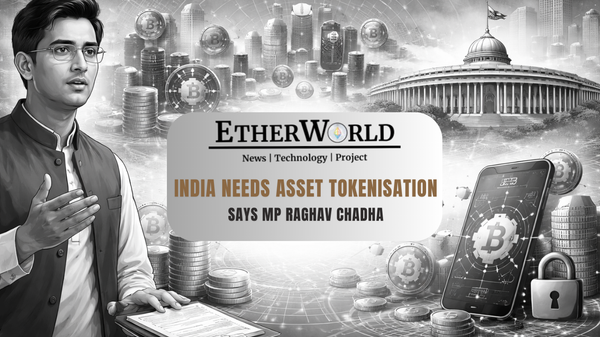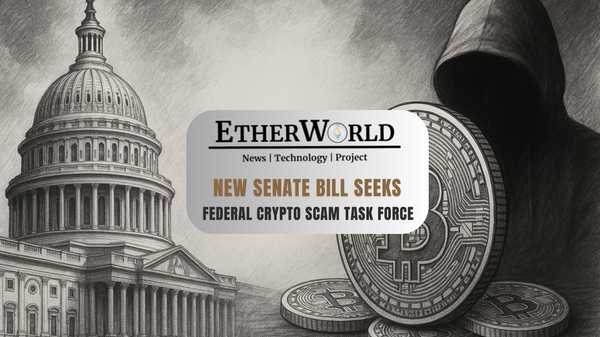India has started a complete review of its virtual digital asset framework. This shift comes at a time when the country is exploring its first sovereign backed stablecoin, regulators are sharpening warnings about irresponsible crypto activity, and enforcement agencies are uncovering major scams involving digital assets.
Together these developments have created the strongest push so far for India to rethink how it governs this emerging sector.
- Why India Is Reviewing Its Crypto Rules
- What This Review Could Change
- How The Overhaul May Shape India’s Crypto Future
Why India Is Reviewing Its Crypto Rules
To understand why this review is happening now, it helps to look at three major developments that arrived almost together.
- The first trigger is India’s ongoing exploration of a sovereign backed stablecoin. Earlier this month, EtherWorld reported that the government has begun outlining a framework for a digital rupee backed token that would operate under official oversight.
Such an ambitious currency system cannot be built on top of unclear or outdated regulatory rules. The stablecoin proposal therefore placed urgent pressure on policymakers to evaluate the foundations of India’s digital asset framework.
- The second push came from the Reserve Bank of India. In a recent EtherWorld article, we discussed that a senior RBI official stated: "India must innovate, but it must do so responsibly".
The message was clear. The central bank is not opposed to innovation, but the regulatory structure needs to improve if digital assets are to coexist safely within the financial system.
- The third and most urgent catalyst has been enforcement pressure. The Enforcement Directorate recently uncovered a two hundred eighty five crore scam involving crypto transactions through offshore wallets.
For regulators, this case showed that the current system leaves too much space for fraudulent activity. When users are moving funds across foreign platforms with no Indian oversight, accountability becomes difficult.
All three developments together made it evident that India needs a stronger, clearer and more globally aligned framework.
What This Review Could Change
The government’s internal review is examining multiple elements of the ecosystem, but the common goal is to build a balanced and protective environment for users and innovators. One of the biggest areas under discussion is the classification of digital assets.
India may move toward distinct categories for utility tokens, asset backed tokens, stablecoins and security like instruments. This aligns with global G20 standards and ensures that each type of token is regulated according to its risk profile.
? BREAKING: ?? India Is Reviewing Its Entire Crypto Framework:
— Crypto India (@CryptooIndia) November 24, 2025
India is reviewing its virtual digital asset (VDA) rules to strengthen investor protections, regulate offshore platforms, and align with global G20 standards. pic.twitter.com/mpUdg3q77s
Another area under evaluation is the licensing and operation of exchanges. Many Indian users currently trade on offshore platforms that do not have an Indian presence.
The review may push for clear licensing requirements, financial disclosures, proof of reserves and independent audits. This would help reduce fraud and strengthen transparency.
Taxation is being reexamined as well. The existing tax structure including the thirty percent tax on gains and the one percent TDS has pushed many users to foreign platforms. Policymakers are considering whether a more moderate system would support better compliance and reduce offshore migration.
Stablecoins are receiving specific attention. If India introduces a sovereign backed digital token, then the broader ecosystem must support strong reserve audits, transparent governance and predictable issuance controls.
Private stablecoins may also be required to follow strict transparency norms for user safety. Market integrity is part of the review too.
Regulators want to curb practices like wash trading, extreme leverage and artificially inflated volumes. Platforms serving Indian users, whether based in India or abroad, may have to follow uniform reporting and surveillance obligations.
How The Overhaul May Shape India’s Crypto Future
The impact of this review will be felt across investors, exchanges, builders and policymakers.
- For investors, a clear and modern rulebook means better protection. It helps users understand their rights and reduces exposure to unregulated offshore platforms.
- For exchanges, the effect will depend on their existing standards. Indian platforms that already follow strong compliance routines may benefit from a more structured environment.
- For builders and innovators, clarity is a major advantage. Many Indian Web3 startups incorporate outside the country due to regulatory uncertainty.
- For policymakers, this overhaul improves India’s international standing. During its G20 leadership, India repeatedly called for coordinated global rules for digital assets.
The sovereign backed stablecoin initiative is an example of how India is thinking ahead. A transparent digital rupee backed token could modernize settlements and support new financial use cases. But this innovation can only succeed if the ecosystem around it is regulated and trustworthy.
India’s decision to reassess its crypto framework is a sign of maturity. It reflects a desire to balance innovation with safety, encourage responsible experimentation and protect users from rising risks.
This review is India’s opportunity to build one of the most comprehensive and globally aligned digital asset frameworks in the world. For investors, exchanges and builders, the next few months will define the direction of the Indian crypto industry for years to come.
If you find any issues in this blog or notice any missing information, please feel free to reach out at yash@etherworld.co for clarifications or updates.
Related Articles
Disclaimer: The information contained in this website is for general informational purposes only. The content provided on this website, including articles, blog posts, opinions, & analysis related to blockchain technology & cryptocurrencies, is not intended as financial or investment advice. The website & its content should not be relied upon for making financial decisions. Read full disclaimer & privacy policy.
For Press Releases, project updates & guest posts publishing with us, email contact@etherworld.co.
Subscribe to EtherWorld YouTube channel for ELI5 content.
Share if you like the content. Donate at avarch.eth.
You've something to share with the blockchain community, join us on Discord!








